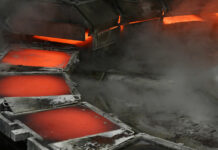
ALPHAMIN Resources said poor road conditions, which were exacerbated by heavy seasonal rains, were likely to result in lower than guided tin sales for its 2023 financial year.
The Toronto- and Johannesburg-listed company operates the Bisie mine in nothern Democratic Republic of Congo. Production from the mine accounts for about 4% of world tin supply.
Road conditions, which in this part of the Congo are already poor, “have further deteriorated with ongoing heavy rains which are only recently showing signs of subsiding,” Alphamin said on Wednesday.
As a result of increased truck transit times, contained tin sales for the fourth quarter are now expected to be between 2,000 tons and 2,200 tons compared to 3,110 tons in the third quarter, it said.
The outcome is that production for the 12 months ended December was estimated to be 12,500 tons compared to guidance of 12,000 tons whereas sales were likely to be 11,400 tons – lower than the forecast 12,000 tons.
The rains also resulted in a one month delay to the commissioning of the firm’s Mpama South processing plant expansion which would now be completed in February with ore processing due from the end of March. Historically, the months of December, January and February are relatively dry from a rainfall perspective.
However, the Mpama South underground mine is operational and has commenced with the stockpiling of ore on surface in preparation for a rapid ramp-up during plant commissioning, said Alphamin.
The development of Mpama South is expected to increase Alphamin’s annual tin production by 65% to a targeted 20,000 tons from the 2024 financial year.
Tin has been described as the glue of the internet of things. The reference is to its end use as a solder in the manufacture of electronics, as well as packaging. Tin also has an application in the manufacture of lithium-ion batteries. Cited by a Reuters report last year, the International Tin Association reckoned 60,000 tons of tin demand can come from electric vehicles alone.
Alphamin’s studies suggest that even at an annual growth rate of between 2% to 3% an additional 8,000 to 10,000/t in tin demand will be generated.










